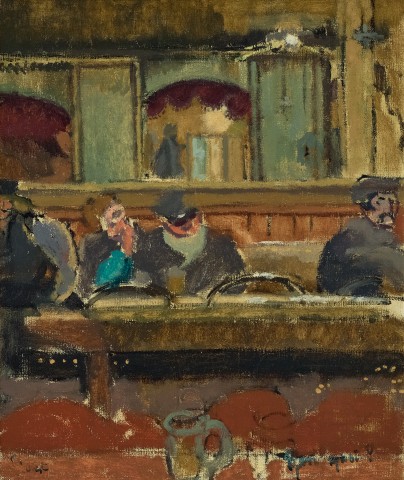BON QUOI?, c.1921 – 22
WALTER SICKERT R.A.
oil on canvas
60.5 x 50.5 cm
signed lower left: Sickert
inscribed with title lower right: Bon Quoi?
Arthur Tooth & Sons Ltd, London (label attached verso)
Private collection
Sir Keith Murdoch, Cruden Farm, Victoria, by 1938
Thence by descent
Dame Elisabeth Murdoch, Cruden Farm, Victoria
Thence by descent
Private collection, Melbourne
Special Exhibition of Contemporary British and Continental Artists, National Art Gallery of New South Wales, Sydney, 19 October – 31 December 1938 (label attached verso)
Walter Richard Sickert, Adelaide Festival of Arts, Art Gallery of South Australia, Adelaide, 7 – 23 March 1968 [fragment of exhibition label verso]
Au cafe concert, Vernet’s Dance Hall, 1920, oil on canvas, 71.0 x 48.0 cm, private collection
We are grateful to Katy Norris and Emma Hicks, London, for their assistance with this catalogue entry.
Walter Sickert is one of the most important British artists who bridged the gap between impressionism and the modern movement. A member of the Chelsea Arts Club, he was elected to the ranks of the Royal Academy in 1936 after having co-founded in previous decades such influential collectives as the New English Art Club and the Camden Town Group. Yet despite such achievements, his ‘longstanding connection to European culture and contemporary French painting set him apart from his British peers.’1 In particular, Sickert enjoyed a long association with the northern French town of Dieppe, and Bon Quoi?, c.1921-22, belongs to his last extended stay there following the death of his second wife Christine from tuberculosis in 1920. Now aged sixty, Sickert was lost in melancholic reverie, visiting old haunts he’d known from before the First World War trying to recapture some of the lost charm of his former life.
Sickert’s mother had grown up in Dieppe and her son spent many childhood holidays there in her company. Located by the Arques River on the Alabaster Coast of Normandy, the port town and bathing resort was popular in the late nineteenth-century with artists and writers such as Aubrey Beardsley, Oscar Wilde, and Max Beerbohm. In 1885, following a short apprenticeship with James McNeil Whistler, Sickert married Ellen Cobden in London and they honeymooned in Dieppe. Whilst there, he re-encountered the revered impressionist Edgar Degas and the two went on numerous painting expeditions together, with the elder artist assuming the role of mentor.2 In 1899, Sickert separated from his wife and moved into the home of his Dieppe mistress Augustine, with whom he lived until 1905. He learned the dialect of the local fishing community which allowed him to move seamlessly ‘between the roles of middle-class respectability and bohemian artist.’3 In 1912 Sickert and his new wife Christine bought a villa in the valley of Eaulne ten miles inland from Dieppe but with the eruption of war, they moved back to England. The couple planned to return in 1919 but Christine became seriously ill with tuberculosis and died in October the following year.
Grieving and alone, Sickert moved into a new studio near Dieppe harbour in 1921, focussing on figure paintings and scenes around the town. In particular, he painted a sequence of interior and exterior views of the cafe-cabaret (beuglant) Chez Vernet, located at the far end of the Quai Henri IV facing the harbour. Sickert passed the time there each evening sketching patrons and performers while waiting for the gaming tables to open at midnight at the town’s famed casino. In Bon Quoi?, the artist shows customers seated at one of the tables which ran down the left-hand side of the narrow venue, also seen in such works as Au cafe concert, Vernet’s dance hall, 1920 (private collection); plus details of the interior walls visible in O nuit d’amour, c.1922 (Manchester City Galleries). Unable to rekindle his former happiness, Sickert returned to England in late 1922 and settled near Bath, but his lingering sorrow is underscored by the piquancy of the title Bon Quoi?, which translates as ‘what’s the point?’.
Sir Keith Murdoch owned at least two other works by the artist: Grand Canal, Venice, c.1901, which was purchased by the National Gallery of Victoria from the three-day auction held subsequent to Murdoch’s death in 1953, and Whistler’s studio, c.1915 – 17, gifted the same year by Lady Murdoch to the Queensland Art Gallery in memory of her beloved husband.
1. Norris, K., ‘Sickert in Dieppe: the art of modern life’, Perspectives (online), Pallant House Gallery, Chichester, England, 2019. www.Pallant.org.uk/perspectives-sickert-in-dieppe/ Viewed 9 October 2021
2. Whistler first visited Degas in his studio in Paris two years previously.
3. Norris, K., Ibid.
ANDREW GAYNOR
